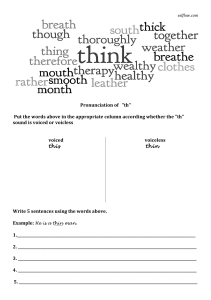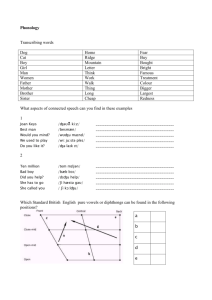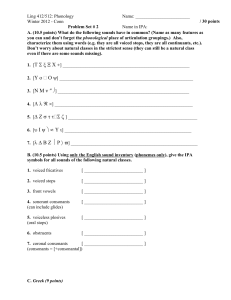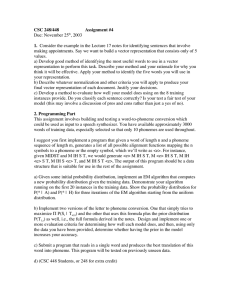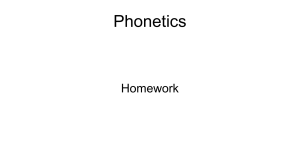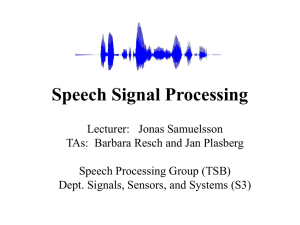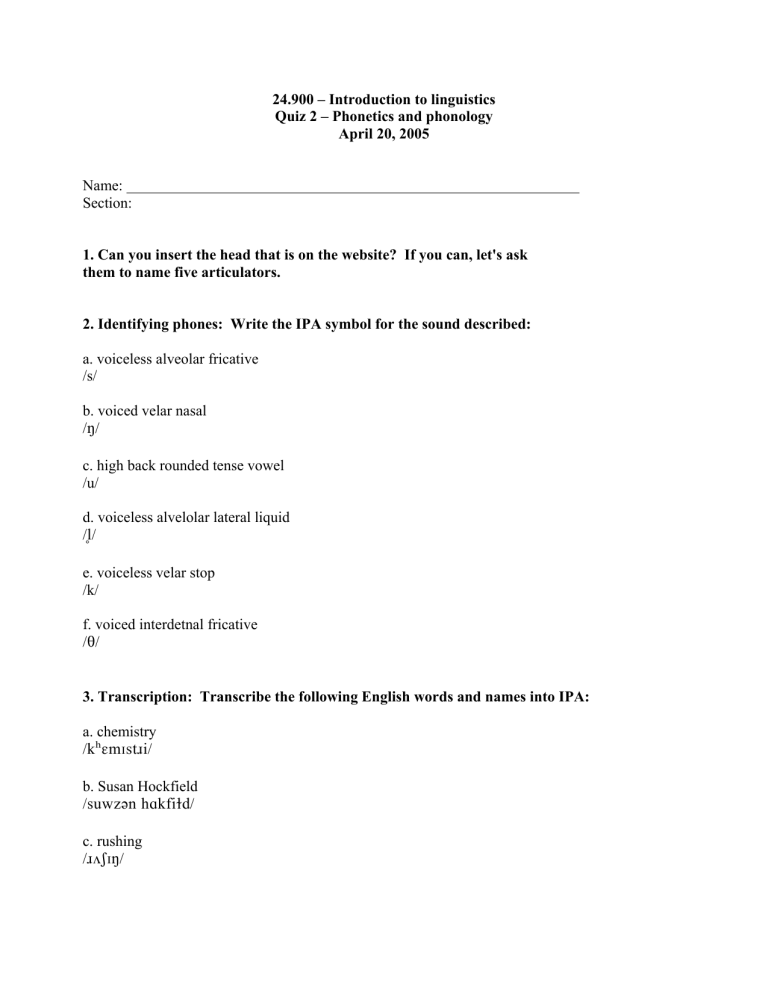
24.900 – Introduction to linguistics Quiz 2 – Phonetics and phonology April 20, 2005 Name: Section: 1. Can you insert the head that is on the website? If you can, let's ask them to name five articulators. 2. Identifying phones: Write the IPA symbol for the sound described: a. voiceless alveolar fricative /s/ b. voiced velar nasal /N/ c. high back rounded tense vowel /u/ d. voiceless alvelolar lateral liquid /l8/ e. voiceless velar stop /k/ f. voiced interdetnal fricative /T/ 3. Transcription: Transcribe the following English words and names into IPA: a. chemistry /kHEmIst®i/ b. Susan Hockfield /suwz´n hAkfi…d/ c. rushing /®√SIN/ d. questions /kw8ESn1s/ e. Tim the Beaver /tHIm D´ biv®1/ 4. Transcription: Transcribe the following words in IPA into English. a. DE® A® bEdb√gz In maj p´dZQm´z there are bedbugs in my pajamas b. T®i ´v Diz bER´® w´nz wI… du TQNk ju three of these better ones will do, thank you c. hi w´z k√v´®d wIT m√ltik√l´®d fET´®z he was covered with multicolored feathers d. dId ju b®IN D´ bejt Qnd D´ fIShUks did you bring the bait and the fishhooks? e. DIs wI… mowst lajkli sawnd st®ejndZ tu mEni lINgwIsts this will most likely sound strange to many linguists 5. Define the following terms. Be brief but make sure you have fully defined the concept: (Use examples where you can) a. phoneme A phoneme is a chunk of speech of conventional size (made in the image of a letter in alphabetic writing systems) that stands in meaningful (i.e., lexeme-differentiating) contrast to other chunks of speech of the same size in the same position. In English, for instance, the two chunks [b] and [p] are distinct phonemes, since they produce a meaning contrast in pairs such as “pet” vs. “bet”. b. allophone: An allophone is each of the different phonetic forms that a phoneme can take; for instance, [l] and […] are two allophones of the phoneme [l] in English that are in complementary distribution. c. complementary distribution Two items are in complementary distribution if the sets of environments in which each occurs have a null intersection. d. overlapping distribution Two items have overlapping distribution if they can both occur in the same environment (i.e., the intersection of the set of environments in which each occurs is non-null). e. minimal pair A minimal pair is a pair of forms that are identical except for a minimal difference, which is relevant for meaning contrast. The example given in (a) above is a minimal pair. 6. What do the following sets of sounds have in common in terms of distinctive features: a. D v Z z [+voice, +continuant, -sonorant] (other features redundant) b. o u U ç [+vocalic, +tense, +back/round] c. l ´ ® m n N a w j E [+sonorant] 7. Mohawk Stops (from Halle and Clements, Problem Book in Phonology) Mohawk, a Northern Iroquoian language spoken in upstate New York, Ontario and Quebec, has six phonetic oral stops (as well as a glottal stop, which we will disregard here). The bilabial stops are rare and for the most part restricted to recent loan words. Decide which of the following two hypotheses is correct: Hypothesis A: Mohawk has the six distinct oral stop phonemes /p b t d k g/. Hypothesis B: Mohawk has only three distinct oral stop phonemes in its underlying phoneme inventory. If you select hypothesis A, show that the inventory of stop phonemes cannot be reduced, by citing (near-)minimal pairs.1 If you select hypothesis B, show that it is correct by (a) listing the phonemes, and (b) listing each variant (surface reflex) of each phoneme together with the context in which it occurs. (Assume that the data is complete in all relevant respects.) The data have been adapted to conform to the IPA. 1. 2. 1 oli˘de/ zahset ‘pigeon’ ‘hide it!’ 8. 9. oya˘gala ohjotsah ‘shirt’ ‘chin’ Hint: to show that two sounds contrast in a given language, it’s usually enough to show that both occur (and are distinctive) in the same environment, even if you cannot find an exact minimal pair. Note that in English, there aren’t any minimal pairs involving /T /and /D/, but it’s clear they contrast because they are distinctive in a prevocalic position, as in this vs. thick. Environments that might be relevant for this problem and the next are simple ones such as: before a vowel, at the end of a word, after a stop, etc., but not things of the sort “before the vowel /i/”, “before a sequence of two consonants”, and so on. 3. 4. 5. 6. 7. ga˘lis odahsa wisk degeni aplam ‘stocking’ ‘tail’ ‘five’ ‘two’ ‘Abraham’ 10. 11. 12. 13. 14. labahbet sdu˘ha dZiks desda/n8 de˘zekw8 ‘catfish’ ‘a little bit’ ‘fly’ ‘stand up!’ (sg.) ‘pick it up!’ (sg.) It seems that [p t k] are in complementary distribution with [b d g], the latter occurring before vowels, the latter elsewhere. The one apparent exception to this is [dZiks]; there are two ways out of this: either [dZ] is treated as a single phone (an affricate), and thus is outside the scope of the problem, or the environment for the voiced allophone has to be extended to include the position preceding voiced fricatives/obstruents. 8. Spanish voiced obstruents In most dialects of Spanish, the voiced stops [b d g] alternate with fricatives [B D ƒ] (actually, for most speakers these are pronounced as approximants, but disregard this). Based on the following data given in broad phonetic transcription, give a rule that states the process and the context in the most succinct manner possible, using distinctive features. Again, assume that the data are complete in the relevant respects. 1. 2. 3. 4. 5. 6. 7. 8. 9. fweƒo saNgRe aDa urƒaR duRo baro ezBelto ambas laƒEra ‘fire’ ‘blood’ ‘fairy’ ‘poke around’ ‘tough’ ‘mud’ ‘slim’ ‘both’ ‘the war’ 10. 11. 12. 13. 14. 15. 16. 17. 18. gEra razƒaR mando lERDo aBa esDRuxulo laRBa elBaro dosƒEras ‘war’ ‘tear’ ‘command’ ‘sluggish’ ‘flap’ ‘antepenult’ ‘larva’ ‘the mud’ ‘two wars’ The voiced stops appear as fricatives if they are preceded by a vowel, or the consonants /r/ (both kinds – is there a difference or is this a typo?), /z/, /s/, /l/. They appear as stops after a homorganic nasal, and word-initially. The relevant environment for them to become fricatives seems to be whenever they follow a segment that has airflow through the oral tract; this is usually associated with the feature [+continuant].
